One of the five pillars of traditional Chinese medicine, together with acupuncture, herbal medicine, dietetics, and energy exercises (Qi Gong, Tai Chi), is the therapeutic acupressure massage known as tui na.
How does it work?

Depending on the demands of the patient, the Tui Na massage practitioner may manipulate particular spots or sections of the patient's body with their hands, elbows, arms, or even feet.
The applied pressure awakens the vital energy meridians, controls blood and Qi flow, harmonizes Yin and Yang, and balances the internal organs' operations.
Does it hurt?

Tui Na massage is a vigorous massage, not a soothing one. It demands intense manipulation and very hard pressure. "Tui" means "to push" and "Na" means "to grasp" in Chinese.
Tui Na massage can be uncomfortable to endure because some tension-filled parts of the body can be sensitive to touch.
Pressure, mobilization, stretching, balancing, kneading, and effleurements are some of the several manipulations that are used, each tailored to the demands of the individual. They are all intense, though.
What are the benefits of Tui Na massage?

Many common maladies are treated with this massage:
- Illnesses that can be internal or external, such as colds, migraines, constipation, and anxiety.
- Traumatizing wounds.
- Musculoskeletal disorders, such as joint discomfort, tendinitis, and bursitis.
- Childhood illnesses.
- Age-related diseases.
- It can also be used to increase a healthy person's body's resistance to sickness and stop viruses from entering their body, especially in middle-aged and feeble individuals.








